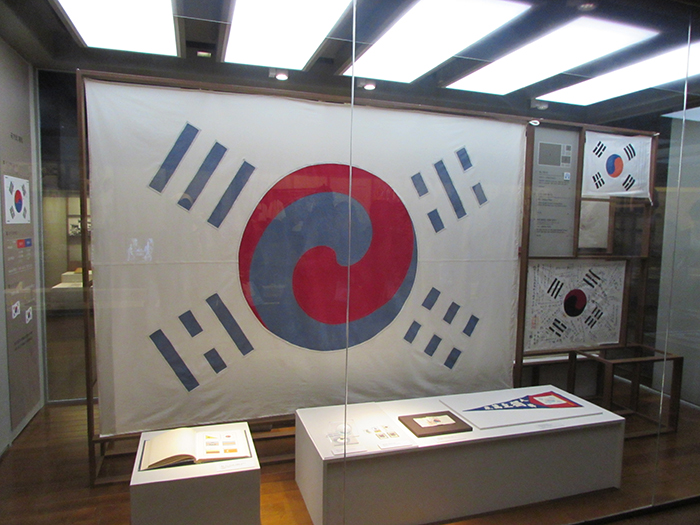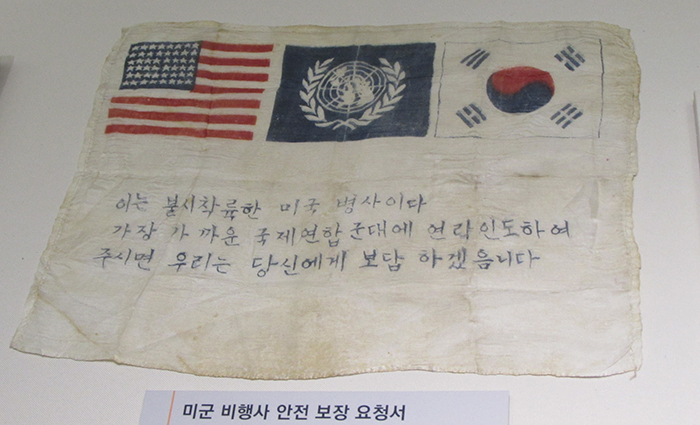
The unified flag of the Korean Peninsula, before the division, is on display at the National Museum of Korean Contemporary History.
By Korea.net Honorary Reporter Esraa Elzeny from Egypt
Photos = Esraa Elzeny
“People make history, and not the other way around. In periods where there is no leadership, society stands still. Progress occurs when courageous, skillful leaders seize the opportunity to change things for the better.”
I like visiting museums a lot. When I visited Korea in 2016, I visited the National Museum of Korea in Seoul and was very impressed with the history of ancient Korea and the harmony of Korean history with ancient world civilizations. This time, in April, I visited the National Museum of Korean Contemporary History. It was a newly opened museum in 2012. I liked it a lot.
There are four exhibitions discussing the history of modern Korea. One of the translators took us on a beautiful journey where we lived every moment of Korea's history from 1876 until today.
Exhibition Hall 1, "Prelude to the Republic of Korea (1876 ~ 1948)," shows an overview of Korean territory, the geographical boundaries of the Korean Peninsula, the Japanese colonization of the Korean Peninsula, Korea's independence in 1945, and the Korean War, "Partition of Korean Peninsula."

Among the items on display is a letter from a U.S. soldier requesting assistance.
Exhibition Hall 2 shows the foundation of the Republic of Korea from 1948 to 1961, the beginning of improvements in the education system, buildings and construction. It was the most difficult stage in modern Korean history, starting with zero infrastructure. Sweat and tears were shed for the development of the Korean state and the establishment of a postwar Korean government.
Hope for a bright future continued until the outbreak of the April 19 Revolution, which was the spark of the democratic movement in Korea, which overthrew the dictatorship by the power of the citizens.
Exhibition Hall 3 shows the development of the Republic of Korea from 1961 to 1987, the beginning of the economic recovery and prosperity of the state of Korea and the harvest of the fruits of sacrifices. I was very impressed by all this. I know now why the Koreans feel grateful to their great forefathers, as wisdom says that, "Without the bitterness of coffee, we wouldn’t enjoy the taste of sweets. That is life. Without the bitterness of the difficulties, we would not enjoy the sweet taste of victory."
Exhibition Hall 4 shows Korea’s advancement, a leap toward the world after 1987. Korea entered competition against the largest economies and the greatest industries after 1987 through to the present day. It has been an era of progress and prosperity when many achievements have been made, including the Olympic Summer Games, the World Cup and the Olympic Winter Games.

Some of the items on display at the museum honor Korea's co-hosting of the 2002 World Cup.
Our visit to the museum happened around the time when the 2018 Inter-Korean Summit was held. I hope that this historic achievement will be added to the museum and add a new exhibition entitled "Next Spring" to commemorate this historic summit.
Korea is great and continues to dazzle the world as always. The Inter-Korean Summit was a courageous step toward peace. History will remind everyone who participated in this summit. I hope that Korea and its people live in peace and love forever.
wisdom117@korea.kr
* This article is written by a Korea.net Honorary Reporter. Our group of Honorary Reporters are from all around the world, and they share with Korea.net their love and passion for all things Korean.